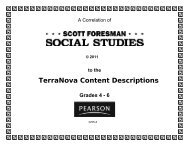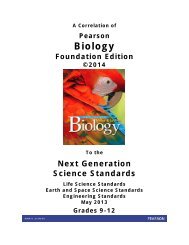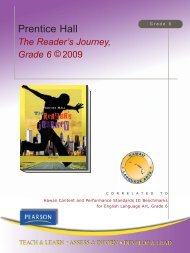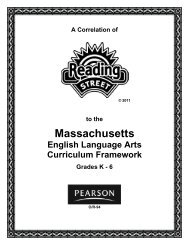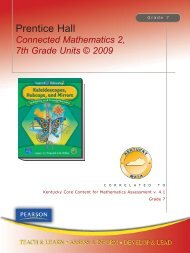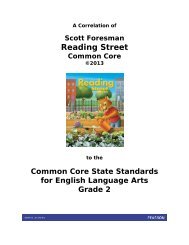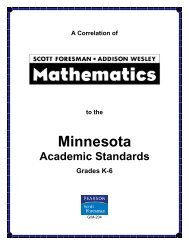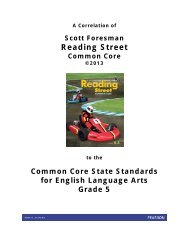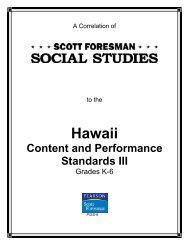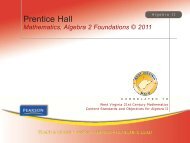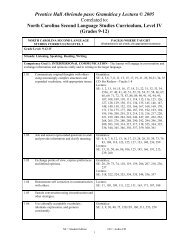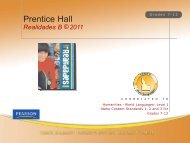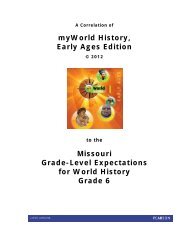A Correlation of<strong>Miller</strong> & <strong>Levine</strong> <strong>Biology</strong>, ©2014to the Next Generation Science Standards, May 2013Grades 9-12HS-LS1 From Molecules to Organisms: Structures and ProcessesHS-LS1 From Molecules to Organisms: Structures and ProcessesStudents who demonstrate understanding can:HS-LS1-1. Construct an explanation based on evidence for how the structure of DNA determines the structure of proteinswhich carry out the essential functions of life through systems of specialized cells. [Assessment Boundary: Assessment does not includeidentification of specific cell or tissue types, whole body systems, specific protein structures and functions, or the biochemistry of protein synthesis.]<strong>Miller</strong> & <strong>Levine</strong> <strong>Biology</strong>: Students are introduced to the structure of DNA in Lesson 12.2 (pp. 344–348) and to DNA replication in Lesson12.3 (pp. 350–352). Lessons 13.1 and 13.2 (pp. 362–371) provide evidence for how the structure of DNA determines the structure ofproteins.Students construct an explanation based on evidence about how the structure of DNA determines the structure of proteins: Studentsexplain how the unique structure of DNA makes the functions of DNA possible (Q2, p. 355). Students write a paragraph explaining thecentral dogma of molecular biology—information is transferred from DNA to RNA to protein (TE p. 371). Students explain the roles of thethree types of RNA in using the information stored in DNA to make proteins (Q38, p. 388).HS-LS1-2. Develop and use a model to illustrate the hierarchical organization of interacting systems that provide specificfunctions within multicellular organisms. [Clarification Statement: Emphasis is on functions at the organism system level such as nutrient uptake, water delivery,and organism movement in response to neural stimuli. An example of an interacting system could be an artery depending on the proper function of elastic tissue and smooth muscleto regulate and deliver the proper amount of blood within the circulatory system.] [Assessment Boundary: Assessment does not include interactions and functions at the molecular orchemical reaction level.]<strong>Miller</strong> & <strong>Levine</strong> <strong>Biology</strong>: Students are introduced to levels of organization in Lesson 7.4 (p. 216). Plant structure and function is addressedthroughout Chapter 23 (pp. 664–687). Lessons 27.1 (pp. 782–786), 27.2 (pp. 787–790), 27.4 (pp. 794–798), 28.2 (pp. 814–818), 28.3 (pp.819–826), and 28.4 (pp. 827–830) focus on the interacting systems in animals. The corresponding systems in humans are addressed inLessons 30.1 (pp. 862–867), 30.3 (pp. 875–881), 30.4 (pp. 882–887), 31.1 (pp. 896–900), 32.1 (pp. 922–927), 33.1 (pp. 948–953), 33.3(pp. 963–969), 34.1 (pp. 978–981), 34.2 (pp. 982–987), and 35.1 (pp. 1010–1013). 35.2, Immune System, pp. 1014-1019Representative examples of how students develop and use a model to illustrate the organization of systems that provide specific functions:Students draw a diagram of a cell membrane and use it to explain how the cell regulates what enters or leaves the cell (Q1 and Q2, p.219). Students make a model of a seed plant and explain how the model would change if the plant grew in a wet environment (Q1 and Q2,p. 689). Students draw a Venn diagram to relate the four levels of organization in the human body (Q3, p. 867). Students evaluate theusefulness of a swimming pool filter as a model for a nephron (Q1, p. 889).HS-LS1-3. Plan and conduct an investigation to provide evidence that feedback mechanisms maintain homeostasis. [ClarificationStatement: Examples of investigations could include heart rate response to exercise, stomate response to moisture and temperature, and root development in response to waterlevels.] [Assessment Boundary: Assessment does not include the cellular processes involved in the feedback mechanism.]MILLER & LEVINE BIOLOGY: The term homeostasis is defined in Lesson 1.3 (p. 19). Students learn how cells maintain homeostasis inLesson 7.4 (pp. 214–217) and the role that stomata play in maintaining homeostasis in plants in Lesson 23.4 (pp. 682–683). The termfeedback inhibition is defined in Lesson 25.1 (p. 732). Lesson 28.4 (pp. 827–830) explains why all body systems must work together.Mechanisms that control kidney function, gas exchange, and blood glucose levels are discussed in Lesson 30.4 (p. 886), Lesson 33.3 (pp.966–967), and Lesson 34.2 (p. 984), respectively.Students plan and conduct investigations that provide evidence about homeostasis and feedback mechanisms: Students examineleaves to determine the average number of stomata per square inch (Quick Lab, p. 683). Students develop a method for maintaining waterat a specific temperature for fifteen minutes (Quick Lab, p. 866). Students explore how plant hormones affect leaf loss (Lab Manual A, pp.147–150) and how chemicals affect heart rate in Daphnia (Lab Manual A, pp. 265–269).HS-LS1-4. Use a model to illustrate the role of cellular division (mitosis) and differentiation in producing and maintainingcomplex organisms. [Assessment Boundary: Assessment does not include specific gene control mechanisms or rote memorization of the steps of mitosis.]<strong>Miller</strong> & <strong>Levine</strong> <strong>Biology</strong>: The process of cell division is described in Lesson 10.2 (pp. 279–285). The process of cell differentiation isintroduced in Lesson 10.4 (pp. 292–297). In Lesson 13.4 (pp. 381–383), students learn that genes control the differentiation of cells incomplex organisms.Students use a model to illustrate their understanding of cellular division in complex organisms: Students use a Visual Summary of mitosisto explain the critical relationship between the breakdown of the nuclear envelope and the formation of the mitotic spindle (p. 285). Studentsdraw a model of the cell cycle for a eukaryotic cell; label key events that result in growth and cell division; and expand the model toinclude two additional rounds of cell division (Q1 and Q2, p. 299). Students with special needs use physical models of cells to feel anddescribe the structural differences between stem cells and differentiated cells (TE p. 295). Students compare the processes cells use toSE = Student Edition; TE = Teacher’s Edition; LMA = Lab Manual A 4
A Correlation of<strong>Miller</strong> & <strong>Levine</strong> <strong>Biology</strong>, ©2014to the Next Generation Science Standards, May 2013Grades 9-12regulate gene expression to a “build to order” manufacturing model (Q4, p. 385).HS-LS1-5. Use a model to illustrate how photosynthesis transforms light energy into stored chemical energy. [ClarificationStatement: Emphasis is on illustrating inputs and outputs of matter and the transfer and transformation of energy in photosynthesis by plants and other photosynthesizing organisms.Examples of models could include diagrams, chemical equations, and conceptual models.] [Assessment Boundary: Assessment does not include specific biochemical steps.]MILLER & LEVINE BIOLOGY: The term photosynthesis is defined in Lesson 3.2 (p. 70) and in Lesson 8.1 (p. 228). Lesson 8.2 (pp. 230–234) presents an overview of the process of photosynthesis. Lesson 8.3 (pp. 235–241) provides details about the light-dependent and lightindependentsets of reactions.Representative examples of how students use a model to illustrate the conversion of light energy into chemical energy duringphotosynthesis: Students use a visual model to determine what happens to the ATP and NADPH produced during the light-dependentreactions (Figure 8–7, p. 233). Students use a visual model to determine how many molecules of ATP are needed for each iteration of theCalvin cycle (Figure 8–11, p. 238). Students draw and label a model of a chloroplast; indicate the key events in the conversion of sunlightto chemical energy; and expand the model to show the location of photosystems (Q1 and Q2, p. 243). Students working in small groupsconstruct a physical model of photosynthesis that includes both the light-dependent and light-independent reactions (TE p. 242).HS-LS1-6. Construct and revise an explanation based on evidence for how carbon, hydrogen, and oxygen from sugarmolecules may combine with other elements to form amino acids and/or other large carbon-based molecules. [ClarificationStatement: Emphasis is on using evidence from models and simulations to support explanations.] [Assessment Boundary: Assessment does not include the details of the specificchemical reactions or identification of macromolecules.]<strong>Miller</strong> & <strong>Levine</strong> <strong>Biology</strong>: Carbon compounds are introduced in Lesson 2.3 (pp. 45–49). Students learn about the organelles that buildproteins and the organelles that capture and store energy in Lesson 7.2 (pp. 200–202). Lesson 13.2 (pp. 366–371) provides more detailsabout the synthesis of proteins in ribosomes. Lesson 30.2 (pp. 865–873) focuses on the nutrients in food that supply the raw materials thatare used to build and repair tissues. In Lesson 30.3 (pp. 875–881), students learn how the digestive system converts food into smallmolecules that can be used by cells in the body.Students construct an explanation based on evidence for how elements combine to form carbon-based molecules: Studentsdemonstrate their understanding of how the body converts food into useful molecules by developing an analogy for each of the fourfunctions of the digestive system (TE p. 875).HS-LS1-7. Use a model to illustrate that cellular respiration is a chemical process whereby the bonds of food molecules andoxygen molecules are broken and the bonds in new compounds are formed resulting in a net transfer of energy. [ClarificationStatement: Emphasis is on the conceptual understanding of the inputs and outputs of the process of cellular respiration.] [Assessment Boundary: Assessment should not includeidentification of the steps or specific processes involved in cellular respiration.]<strong>Miller</strong> & <strong>Levine</strong> <strong>Biology</strong>: Lesson 9.1 (pp. 250–253) provides an overview of cellular respiration. Lesson 9.2 (pp. 254–260) providesadditional details.Representative examples of how students use a model to illustrate their understanding of cellular respiration: Students make a sketch ofthe overall process of cellular respiration (TE p. 254). Students make a simplified drawing of cellular respiration that shows how thereactants and products at each stage are related (TE p. 259). Groups of students write a screenplay that shows how energy is produced in acell (TE p. 266). Students use sketches to show how the processes of respiration and cellular respiration are related (Q37, p. 270).The performance expectations above were developed using the following elements from the NRC document A Framework for K-12 Science Education:SE = Student Edition; TE = Teacher’s Edition; LMA = Lab Manual A 5



